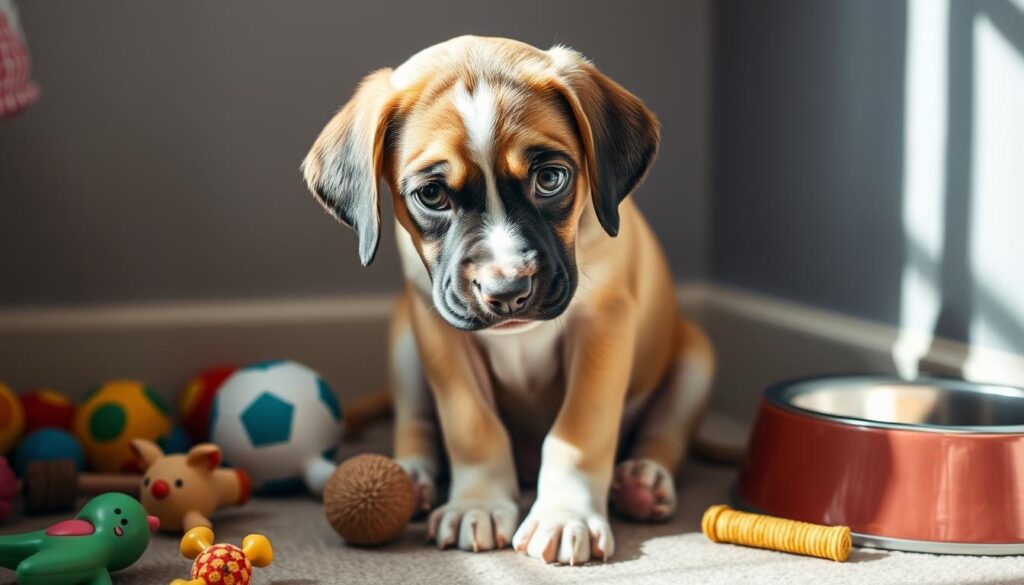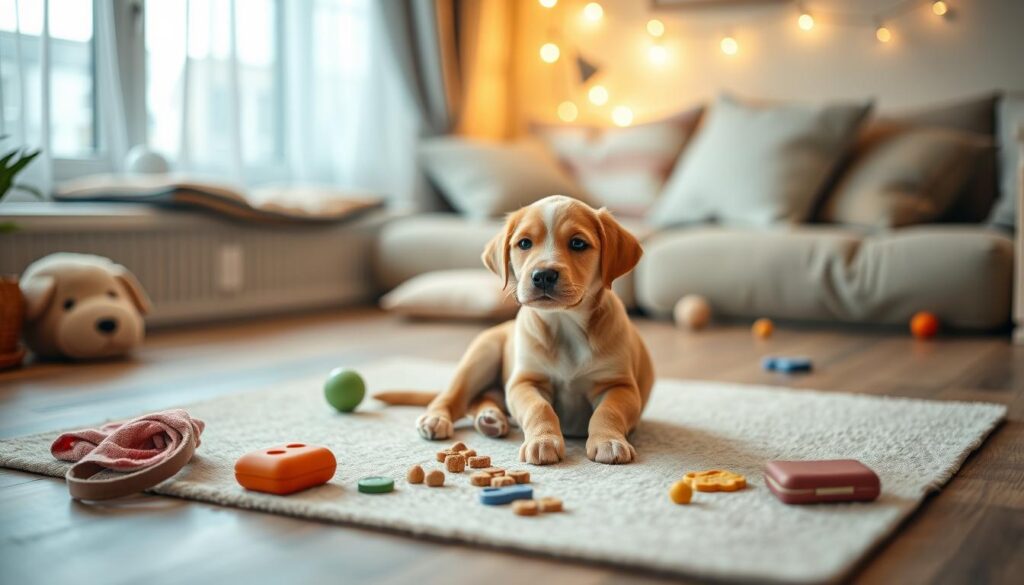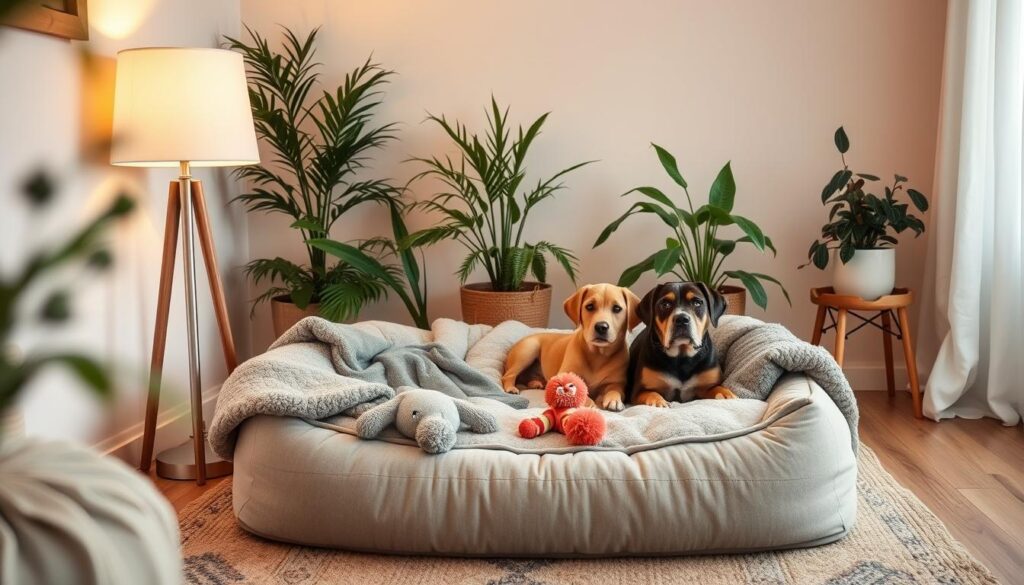Have you ever thought if your pet is feeling anxious? Spotting early signs of anxiety in your puppy is key for their happiness. Dogs, like us, can feel anxious and it affects their behaviour and life quality. But can you spot the tiny signs of puppy anxiety?
Key Takeaways
- Recognising the early signs of anxiety in your puppy is crucial for their wellbeing.
- Dogs can experience different types of anxiety that can impact their behaviour and quality of life.
- Identifying the subtle signs of puppy anxiety is essential to provide the necessary support and intervention.
- Lack of socialization during the critical period can lead to fearful and aggressive behaviour later in life.
- Desensitizing dogs to their triggers and using pheromone therapy can effectively reduce fear and stress.
Understanding Anxiety in Puppies
Anxiety in puppies can show up in many ways, like fear, phobias, and separation anxiety. Knowing what kind of anxiety your puppy has is key to helping them feel better.
Types of Anxiety in Dogs
Fear is a natural response to something scary. If the threat isn’t real, it can lead to bad behavior. Phobias are when dogs are too scared of certain things, like loud noises or storms. Separation anxiety happens when a puppy gets really upset when left alone, even for a little while.
Puppies need to meet other dogs and people between 4-16 weeks old. If they don’t, they might grow up to be scared or aggressive. It’s important to introduce them to new things before they’re 16 weeks old to avoid problems later.
| Type of Anxiety | Description |
|---|---|
| Fear | An instinctive response to a perceived threat, which can lead to inappropriate aggression if the threat is not genuine. |
| Phobias | Excessive fears to specific external stimuli, such as loud noises or thunderstorms. |
| Separation Anxiety | An abnormal reaction to being away from their owner, even for short periods. |
https://www.youtube.com/watch?v=mgPViZGH3sY
It’s important to handle puppies a lot and introduce them to new things during the critical socialization period. This helps them become friendly, confident, and happy dogs. Knowing about different anxieties helps you understand and support your puppy better.
Signs of Stress and Anxiety in Puppies
It’s key to spot the early signs of puppy anxiety symptoms and dog anxiety behaviors to help your pet. As a caring pet owner, knowing your puppy’s emotional state is vital. It greatly affects their happiness and growth.
Signs of dog anxiety include pacing, shaking, and a fast heart rate. Puppies might also show signs of recognizing puppy distress like hiding or acting sad. They could have diarrhoea, accidents, or shed more than usual.
Knowing what’s normal for your puppy helps you notice any anxiety signs. Watch their body language and how they sound. This can tell you a lot about how they’re feeling.
| Anxiety Symptom | Description |
|---|---|
| Pacing | Repetitive, nervous walking back and forth |
| Shaking | Trembling or quivering, often without apparent cause |
| Excessive Panting | Heavy breathing, even when not exercising |
| Yawning | Frequent yawning, not related to sleepiness |
| Drooling | Excessive salivation, especially when anxious |
| Compulsive Behaviors | Repetitive actions like licking or chewing |
| Hypervigilance | Constant scanning of the environment for threats |
By paying attention to your puppy’s behaviour, you can act fast to help. This ensures your furry friend stays happy and healthy.

Common Causes of Puppy Anxiety
Puppy anxiety can come from many sources, both around them and in different situations. Knowing what causes anxiety in puppies is key to helping them feel better. Some main reasons for puppy anxiety triggers include:
- Lack of proper socialization between 4 to 16 weeks of age. Research shows puppies not socialized well during this time may become fearful or aggressive later.
- Loud noises, like thunderstorms, fireworks, or loud appliances, can scare young puppies a lot.
- Being away from their owners, known as separation anxiety in dogs. Up to 20% of dogs suffer from this.
- Meeting new people, animals, or places can stress some puppies out.
- Scary experiences, like being startled or feeling threatened by other dogs, can cause trauma-induced anxiety.
Identifying Anxiety Triggers
To manage your puppy’s anxiety, you need to find out what scares them. Watch how they act in different places and situations. Also, keep a diary of when and where they seem anxious. Some breeds, like German Shepherds and Labradors, might be more likely to feel anxious.
“Dogs can experience fear periods at 8-11 weeks and 5-14 months of age, where they may exhibit hesitancy, skittish behavior, and warning barks.”
By figuring out the environmental stressors for puppies, you can make a plan to help them feel safe. This way, your puppy can enjoy their surroundings without worry.
Recognizing Subtle Signs of Puppy Distress
Puppies can show obvious signs of anxiety like pacing and loud barking. But they also have subtle signs like lip licking, yawning, and stiff posture. Spotting these signs early can help prevent their anxiety from getting worse.
It’s important to watch for changes in your puppy’s mood and body language. This way, you can find out what’s causing their anxiety. By paying attention to these small changes, you can make your puppy feel safe and calm.
Subtle Signs of Anxiety in Dogs
- Lip licking: Puppies may lick their lips as a self-soothing behavior when feeling anxious or stressed.
- Yawning: Excessive yawning can be a sign of anxiety, as puppies may use this to cope with uncomfortable situations.
- Ear signals: Puppies’ ears may be held back or flattened against their head when they feel uneasy or fearful.
- Stiff posture: A rigid, hypervigilant stance with a raised tail can indicate a puppy is feeling stressed or on edge.
By noticing these subtle signs of anxiety, you can start to help your puppy feel better. It’s important to act early to stop their anxiety from getting worse. This can prevent bigger problems later on.
| Subtle Body Language Indicators of Stress in Puppies | What They Might Signify |
|---|---|
| Lip licking | Self-soothing behavior, anxiety |
| Yawning | Coping with discomfort, stress |
| Ear signals (flattened, pulled back) | Feeling uneasy or fearful |
| Stiff, hypervigilant posture | Feeling stressed or on edge |

Spotting these subtle signs of anxiety early can really help your puppy. By paying attention to their body language and mood, you can support them. This creates a calm and safe space for your furry friend.
The Main Keyword “How to Spot Anxiety in Your Puppy Early”
Spotting anxiety in your puppy early is key for their happiness and health. Knowing the different anxieties, the signs, and what might cause them helps a lot. This way, you can help your puppy feel better emotionally.
Fear, phobias, and separation anxiety are big stressors for puppies. Noises like fireworks and thunderstorms can cause phobias. Separation anxiety happens when a puppy gets upset when left alone.
Watching your puppy’s body language is very helpful. A relaxed puppy has open eyes, stands evenly, and has a happy tail. An anxious puppy might pace, shake, or have a fast heart rate. They might also pant, drool, or hide.
It’s important to spot the early signs of anxiety in dogs and recognising anxious puppy behaviour. If you don’t, anxiety can get worse. By paying attention and trusting your gut, you can help your puppy stay happy and healthy.
“The critical socialisation period for dogs is between 4-16 weeks old. Proper exposure to novel situations during this time can lead to a friendly, confident, and happy adult dog.”
If you worry about your puppy’s mood, get help from a vet behaviourist or a certified trainer. They can teach you how to handle your puppy’s anxiety. This way, you can make a safe and loving space for them to grow.

Managing Puppy Anxiety Through Training
Managing puppy anxiety needs a mix of training and changing the environment. Desensitization and counterconditioning are key. This means slowly introducing your puppy to scary things in a safe way. You reward them for staying calm.
Creating a training plan needs a vet or trainer’s help. They’ll figure out what scares your puppy and make a plan. Positive reinforcement and regular routines are crucial. They help your puppy feel safe and learn to handle fears.
Desensitization and Counterconditioning
Desensitization and counterconditioning slowly introduce your puppy to scary things. You pair these with good experiences and rewards. This makes your puppy think the scary thing is good, reducing fear and anxiety.
- Find out what scares your puppy, like being alone or meeting new people or animals.
- Start with a small amount of the scary thing, making sure your puppy stays calm.
- Give your puppy treats, praise, or their favorite toys when they’re calm around the scary thing.
- Slowly increase how much and how long your puppy is exposed to the scary thing, always rewarding calm behavior.
Be patient and let your puppy set the pace. With time and the right help, your puppy can learn to handle their fears and anxiety.

“The key to managing puppy anxiety through training is to create a positive, safe, and predictable environment for your furry friend.”
| Calming Techniques for Puppy Anxiety | Benefits |
|---|---|
| Positive Reinforcement Training | Helps build confidence and trust, and reinforces desirable behaviors. |
| Creating a Consistent Routine | Provides a sense of security and predictability, reducing stress and anxiety. |
| Providing a Safe, Quiet Space | Allows your puppy to retreat and self-soothe when feeling overwhelmed. |
| Pheromone Diffusers or Calming Supplements | Can help reduce physiological signs of anxiety and promote relaxation. |
Creating a Safe Environment for Your Anxious Puppy
It’s vital to make a safe, predictable, and calming space for your anxious puppy. You might need to set up a “safe space” in your home. This area should be where your puppy can go to feel safe. Make sure they have access to water, food, and a comfy place to rest.
Interactive toys and puzzles can help keep your puppy’s mind busy. This can prevent boredom and anxiety. A nurturing and stress-free home helps your puppy feel more at ease. It also helps them deal with their fears and anxieties better.
The first 16 weeks of a puppy’s life are critical for learning. During this time, they learn how to interact with others and their environment. Puppies that don’t meet other dogs and people during this time may become fearful or aggressive later. It’s important to socialize them before they are 16 weeks old to avoid behavioral issues.
Keeping dogs mentally stimulated is key to reducing stress and improving their mood. Activities that challenge their minds are essential. Synthetic pheromones like Adaptil can also help reduce anxiety, making them feel safer. Calming supplements and treats can help ease a dog’s anxiety quickly.
If you think your dog might be anxious, it’s best to see a vet. The AKC GoodDog! Helpline has been helping dog owners for ten years. They offer advice on training and support nearly one million dog owners.

Creating a safe, enriching, and calming environment is crucial for your anxious puppy. It helps them feel secure and reduces their fears and anxieties. Early action and a comprehensive approach to managing puppy anxiety are key for their long-term well-being.
Seeking Veterinary Assistance for Severe Anxiety
If your puppy’s anxiety is severe or doesn’t get better, it’s time to see a vet. They can help your furry friend feel better.
Your vet will first check for any health problems that might be causing the anxiety. Medication for dog anxiety might be suggested, but only with your vet’s advice.
If your puppy needs extra help, your vet might suggest a board-certified veterinary behaviourist. These experts can find the cause of your puppy’s anxiety and create a special plan to fix it. This plan might include training, changes to their environment, and sometimes medication.
Working with your vet and a behaviour specialist is key to your puppy’s emotional health. They can help your puppy overcome their fears and become more confident.
“Seeking professional help for a dog’s anxiety is not a sign of failure, but rather a responsible and caring step in helping your furry friend feel more at ease.”
Getting help for your puppy’s anxiety early can really help their emotional health in the long run. With your vet’s help, you can give your puppy the support they need to feel happier and more confident.
The Importance of Early Intervention
It’s vital to tackle anxiety in puppies early on for their emotional health. If not treated, puppy anxiety can lead to serious problems like destructive or aggressive behaviour. This can greatly affect their quality of life. Recognising early signs and taking action can help your puppy develop good coping skills and avoid long-term anxiety.
The critical socialisation period for dogs is between 4-16 weeks. Puppies not socialised during this time may develop fear and aggression. Early intervention through training, environmental changes, and vet support can greatly help your puppy manage their fears and anxieties.
Symptoms of dog anxiety include lip licking, yawning, trembling, and defensive aggression. Anxiety can be triggered by separation, car travel, moving, or changes in routine. It’s key to socialise puppies before they are 16 weeks old to prevent behavioural issues later.
Research shows that puppies with early signs of anxiety or aggression are unlikely to change as they grow. Early action is essential as puppies with early signs are likely to become fearful or aggressive adults if not helped.
Many puppy behaviour issues can become serious if not addressed early. These can include fear aggression or biting. If your puppy shows serious behaviour issues, seek professional help without delay. Look for board-certified veterinary behaviourists, behaviour consultants, and animal behaviourists from reputable associations.
By tackling puppy anxiety early, you can prevent long-term anxiety issues in dogs. This ensures your puppy has a happy, healthy, and well-adjusted life. Don’t wait until it’s too late – act now to support your puppy’s emotional wellbeing.
Conclusion
Spotting early signs of anxiety in your puppy is key for their wellbeing. Knowing the different types of anxiety and their signs helps a lot. It lets you take steps to support your puppy’s emotional health.
Training, changing the environment, and sometimes vet help can make a big difference. These actions help your puppy learn to cope with anxiety. This way, anxiety won’t control their life forever.
Being patient and consistent is important for your puppy’s emotional health. It ensures they start life well and have a happy future. Managing puppy anxiety and creating a supportive environment are vital for their wellbeing.
By using the tips from this article, you can help your puppy early on. This builds a strong bond and a confident companion. With the right steps, your puppy can face the world with joy and security.



